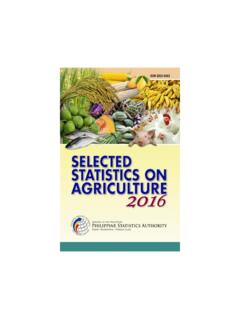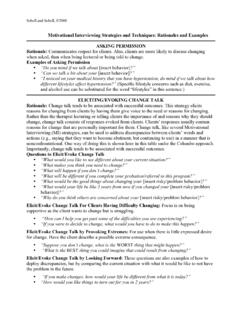Transcription of EVALUATION OF WATER QUALITY OF MAJOR RIVERS IN …
1 EVALUATION OF WATER QUALITY OF MAJOR RIVERS IN PALAWAN, PHILIPPINES USING PHYSICO-CHEMICAL PARAMETERS AND WATER QUALITY INDEX by Marianne Faith G. Martinico-Perez, Jenevieve P. Hara, Madrono P. Cabrestante, Jr. ABSTRACT The RIVERS in Palawan have fundamental roles in local society as source of WATER for recreation; domestic use; irrigation; as well as sink for agricultural and domestic wastes. Beneficial usage of WATER is thus depends on its WATER QUALITY . This study attempts to characterize the WATER QUALITY of MAJOR RIVERS in the province using WATER QUALITY index (WQI) developed by Canadian Council of Ministers of the Environment (CCME). WQI was calculated for thirty six (36) river monitoring stations based on physico-chemical and microbiological parameters vis- -vis freshwater QUALITY standards stipulated in the DENR Administrative Order 34, series of 1990.
2 Results show that all river monitoring stations have description of good to excellent WATER QUALITY if utilized for agriculture, irrigation, and other purposes (Class D). Only five (5) river monitoring stations have good to excellent rating as sources of drinking WATER after a complete treatment (Class A). The WATER QUALITY index is potentially useful as a decision tool in environmental planning and decision-making activities related to WATER resource protection, improvement and utilization towards a sustainable WATER resource management in the province of Palawan. Keywords: WATER QUALITY , DAO standards, physico-chemical parameters, river monitoring, Palawan 1. Introduction RIVERS are the most important natural resources for human consumption and development.
3 It They provides ecosystem services such as fresh WATER sources for domestic and agriculture consumption, WATER regulation, primary production as well as transportation and recreation purposes. However, human activities gradually alter the inland WATER ecosystem and its catchments through land conversion, sand and gravel extraction, and indiscriminate disposal of sewage, agricultural and industrial wastes to WATER bodies. It is therefore necessary to determine the WATER QUALITY and evaluate its impacts and provide measures to mitigate the problems (Mishra et al., 2009). WATER QUALITY monitoring is essential to determine the physical, chemical and biological characteristics of WATER .
4 These characteristics provide basis as to how and for what WATER can be used and the species and ecosystem processes it can support. Monitoring is also the foundation on which WATER QUALITY management is based. It provides the information that permits the rational decision to be made on describing WATER resources, identifying actual and emerging problems of WATER pollution, use and abstraction of WATER , and land use; formulating plans; and in evaluating the effectiveness of management actions (UNEP/WHO, 1996). At the same time, WATER QUALITY monitoring data can be used to track response to management regimes aimed at improving WATER QUALITY . To assess whether the WATER body is fit for various human activities and could support aquatic species and ecosystem processes, various physical, chemical and microbiological parameters are determined through laboratory analyses.
5 With hundreds of parameters available to assess the WATER QUALITY , the challenge remains on providing a single statement that would sum up several WATER QUALITY parameters into one holistic description. Like any other environmental monitoring program, there is a problem on the reporting of WATER QUALITY monitoring results to both managers and the general public because of the complexity associated with analyzing a large number of measured variables. In response to this, numerous WATER QUALITY indices have been formulated all over the world. These indices are based on the comparison of the WATER QUALITY parameters to the standards and give a single value for the WATER QUALITY of a certain source (Bharti and Katyal, 2011).
6 The scatterscore index was used to assess changes in WATER QUALITY of mining sites in USA (Kim and Cardone, 2005); index of river WATER QUALITY was developed and used in Taiwan (Liou et al., 2004); overall index of pollution was used in India (Sargaonkr and Deshpande, 2003); and Chemical WATER QUALITY Index used in USA (Tsegaye et al., 2006) are some of the numerous attempts to simplify complex WATER QUALITY data and monitoring. The WATER QUALITY Index (WQI) developed by Canadian Council of Ministers of the Environment (CCME) in 2001 assesses the QUALITY of WATER against the WATER QUALITY standard set forth by the government agency or site specific background concentration (CCME, 2001).
7 It is among the well-accepted and widely applicable model for evaluating the WATER QUALITY index (Sharma and Kansal, 2011; Damo and Icka, 2013). Because of its versatility, this method was utilized by UNEP GEMS/ WATER programme as the model that can be followed in developing a global WATER QUALITY index (UNEP, 2007). While some countries and regions have developed and are using WATER QUALITY indices that assess WATER QUALITY either on a national or global level, these rely mostly on normalizing or standardizing data parameter according to expected concentrations (Carr and Rickwood, 2008).The CCME WQI, on the other hand, provides a mathematical framework for assessing ambient WATER QUALITY conditions relative to WATER QUALITY standards, thus, reflects the overall and current condition of the WATER bodies.
8 There is no formulated and developed guidelines on WATER QUALITY indices in the Philippines, although there are WATER QUALITY standards used as basis for acceptable values of physico-chemical and microbiological parameters. The Department of Environment and Natural Resources issued the Administrative Order 34 series of 1990 stipulating the WATER QUALITY criteria or standards based on the beneficial usage of the body of WATER or classification of freshwaters and marine waters, providing basis to determine the suitability of WATER bodies for specific use. This study focuses in the province of Palawan, known as the Phillippines last frontier, one of the MAJOR tourist destinations in the country and lauded as the World s Best Island from 2013 to 2016 by the Conde Nast Traveler and Travel+Leisure Magazine.
9 The growing socio-economic activities and demands of increasing population for food and space have impacted the province s WATER resources. The province experiences WATER shortage especially during summer season. The Palawan Council for Sustainable Development Staff (PCSDS) conducts river WATER QUALITY assessment. It has thus, established river monitoring stations in the province to continuously monitor the impacts of socio-economic activities in the WATER resources in the province. However, the accumulated WATER QUALITY data have limited usage in terms of policy formulation in the province. The brief and simple descriptions should be developed in order for these technical data of WATER QUALITY to be translated into simple and understandable to the end user, whether from academe, civil society, to policy makers.
10 This study evaluates the WATER QUALITY of MAJOR RIVERS in the province of Palawan vis- -vis WATER QUALITY standards as stipulated in DAO 34, S. 1990. By utilizing the Canadian WATER QUALITY Index model, this study attempts to verify its applicability in EVALUATION of WATER QUALITY of RIVERS in Palawan. This study aims to come up with description of river systems with different beneficial usage. The empirical data derived in this study could be utilized for the EVALUATION or formulation of policy towards the sustainable WATER resource management in the province. 2. Methodology Sample Collection and Analysis The data used in this study is based on the results of WATER QUALITY monitoring conducted by the Palawan Council for Sustainable Development Staff as part of its activities under the Environmental Monitoring and EVALUATION System.















